
 |
Tea Clipper |
 |
| from TeaAntiques.com | ||
| Edition Sixty Two |
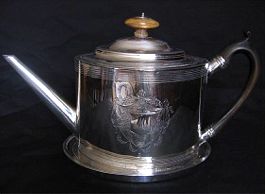 A
truly stunning George III sterling silver teapot and stand, exquisitely decorated
with bright cut decoration, including a very decorative cartouche of a family crest,
this appears on both sides of the teapot together with the centre of the teapot
stand.
A
truly stunning George III sterling silver teapot and stand, exquisitely decorated
with bright cut decoration, including a very decorative cartouche of a family crest,
this appears on both sides of the teapot together with the centre of the teapot
stand.
The teapot is the work of Andrew Fogelberg and was made in London in 1793. The teapot stand, which was obviously made a few years later, having exactly the same decoration and cartouche, is the work of William Fountain and was made in London in 1802. I suspect that the original owner of the teapot, decided later that it should have an accompanying stand and thus had one made to order and to match the teapot exactly.
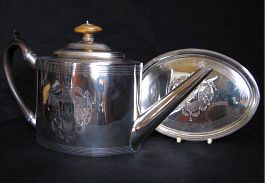
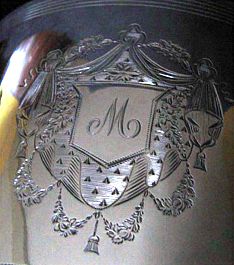
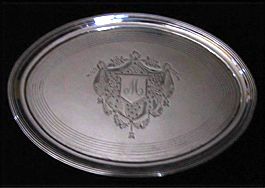
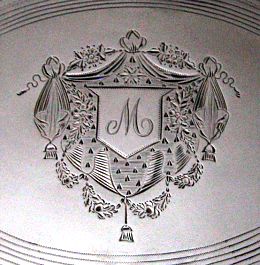 The
crispness of the cartouche bright-cut work, which is contemporary to the teapot,
is excellent.
The
crispness of the cartouche bright-cut work, which is contemporary to the teapot,
is excellent.
As with the teapot, the teapot stand is in remarkably excellent condition. It is oval in shape and in the centre is the same cartouche as on the sides of the teapot.
Both the teapot and stand have very clear hallmarks.
This very elegant George III teapot and stand would grace any fine afternoon treatable and are of the highest quality for the collector of eighteenth century English silver.
More details of this item and other tea related antiques can be found by visiting my web site at www.TeaAntiques.com.
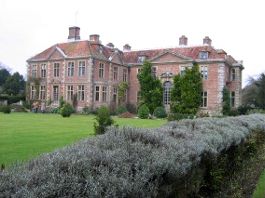 Following
all the excitement of the Christmas festive period, for some weeks afterwards it
always seem rather depressing, with the short dark and cold days still remaining
with us for some time yet. It is then quite refreshing to know that there is the
earliest flowering spring plants to look forward too very soon appearing in our
garden.
Following
all the excitement of the Christmas festive period, for some weeks afterwards it
always seem rather depressing, with the short dark and cold days still remaining
with us for some time yet. It is then quite refreshing to know that there is the
earliest flowering spring plants to look forward too very soon appearing in our
garden.
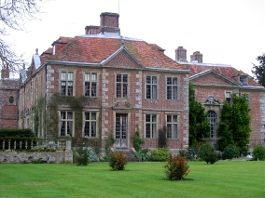 At
this time of year there are a few country house gardens that open their grounds
to the public. One such house is the delightful red brick Heale House in Wiltshire.
In deed, Heale House garden is open throughout the year with the exception of Mondays.
At
this time of year there are a few country house gardens that open their grounds
to the public. One such house is the delightful red brick Heale House in Wiltshire.
In deed, Heale House garden is open throughout the year with the exception of Mondays.
Heale House is situated in low lying ground, a valley through which the River Avon meanders and where snowdrops abound in the month of January and February. There are snowdrop walk days (in 2005, it was 6th and 13th February) arranged with guided tours of the garden if you so wish, and the proceeds of the opening going to charitable causes.
The attractive house, with its mellow red brick and stone dressed façades, has a history dating back to the 16th and 17th century. Many of the owners throughout its long history have made changes to the house, but it still maintains a uniform appearance. It is said that the house was used as a hideaway for King Charles II in 1651, staying hidden in the house for six nights on his flight to Shoreham and from there to refuge in France.
The house is now in the ownership of Guy and Frances Rasch, Guy's ancestors have lived at Heale since 1894 when it was purchased by Guy's Great Great Uncle, Louis Greville.
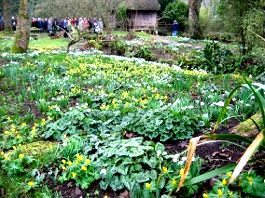 These
snowdrop walk days are very popular and so it is recommended to have an early start.
By the time I arrived mid-morning, the garden had quite a crowd of people enjoying
the winter flowers, some of whom had joined the guided tours of the garden, given
at timed intervals throughout the opening. I was quite content to make my own way
round the garden, to take in the flowers and vistas at my own leisurely pace.
These
snowdrop walk days are very popular and so it is recommended to have an early start.
By the time I arrived mid-morning, the garden had quite a crowd of people enjoying
the winter flowers, some of whom had joined the guided tours of the garden, given
at timed intervals throughout the opening. I was quite content to make my own way
round the garden, to take in the flowers and vistas at my own leisurely pace.
My first glimpse of the charming house was approaching it towards its South Front. There is a delightful symmetrical square five-bayed block on the left hand side, to which is adjoined a set back addition, the East wing which was added in the nineteenth century, when the older wing had been destroyed by fire. This elevation is most attractive, the stone mullioned windows glazed with leaded lights. The mellow coloured bricks and stone provide a soft and perfect combination and exclaim the age of the building. In front of this elevation is the Croquet lawn, with a Lavender edged terrace on the right hand side below which is the Boat Terrace along the edge of the River Avon. The balustrades of the Boat Terrace are draped with roses and Cotoneaster, now covered in red berries.
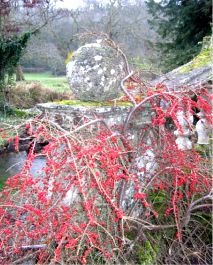
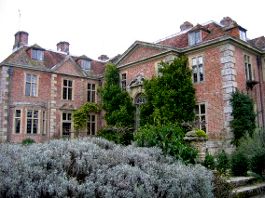

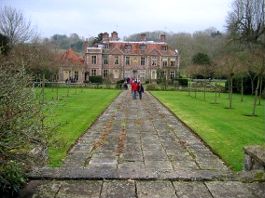
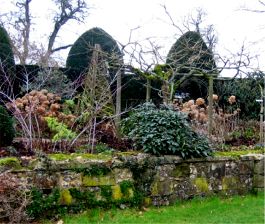 On the West Front of the house, the stone slab drive rises gently through two terraces.
On the lower terrace are two formally shaped ponds. The top terrace has some large
clipped Yew Trees and wooden obelisks through which roses are trained, creating
a formal focal point as viewed from back at the house.
On the West Front of the house, the stone slab drive rises gently through two terraces.
On the lower terrace are two formally shaped ponds. The top terrace has some large
clipped Yew Trees and wooden obelisks through which roses are trained, creating
a formal focal point as viewed from back at the house.
The walk through the wood to the North of the house, takes you along the banks of the River Avon. These banks are awash with the little hanging white heads of the snowdrops. These welcome flowering bulbs provide a carpet white, punctuated in areas with the brilliant yellow of the flowering Aconites. It can feel chilly walking along the valley, with the cold waters of the Avon by your side. at the end of the path is an old thatched mill on the river, providing a perfect picture with the water, snowdrops and green ferns.
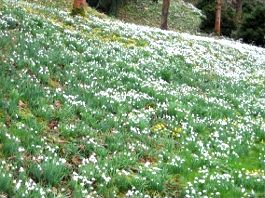
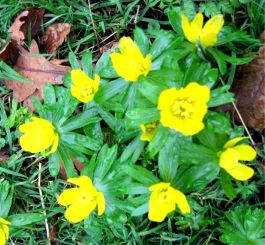
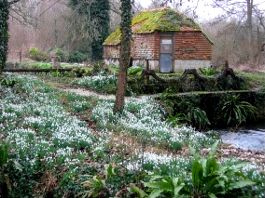
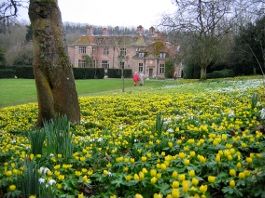 As
I make my way back towards the North front of the house, there is a beautiful view
of the house over a carpet of the yellow aconites, this brings a real touch of Spring
'sunshine' to the garden, very welcome at this time of year.
As
I make my way back towards the North front of the house, there is a beautiful view
of the house over a carpet of the yellow aconites, this brings a real touch of Spring
'sunshine' to the garden, very welcome at this time of year.
In the Southern corner of the garden is the Japanese garden, complete with an authentic Japanese Tea House. I had not expected to find such a Tea House tucked away in an English garden! The Tea House assumes a perfect backdrop to the Japanese garden that has been created, including a Japanese red painted bridge over a branch of the river. The Tea House, together with some stone temple lanterns were brought back from Japan by Louis Greville when he left his position in the Embassy in Tokyo at the end of the nineteenth century. Such tea houses are gauged in size by how many 'tatami' mats can be fitted into the house on the floor. This particular tea house can accommodate eight tatami mats, which means it is quite a large sized tea house. The Tea House sits upon wooden struts holding it above the river. There are also stone supports to take the weight of the tea house, as the wooden supports are now rotting. What a very pleasant place this must be in which to enjoy an afternoon tea in the summer months, the sound of water around you helping to keep you cool, the ornamental Japanese garden to look at and the view of the house beyond.
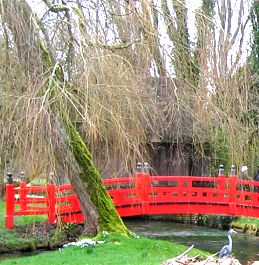
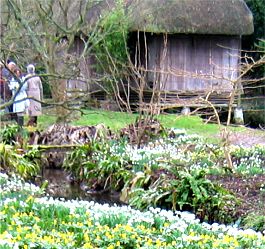
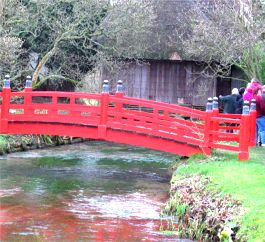
As well as the multitude of snowdrops and aconites, there are many other splashes of colour around the garden at this time of year including the tiny pink and white cyclamens, sweetly scented daphne bushes and some unusually dark hellebores (Lent roses). In these short winter days, what could be more enlightening than to see such a variety of colour appearing around the garden to bring some winter cheer.
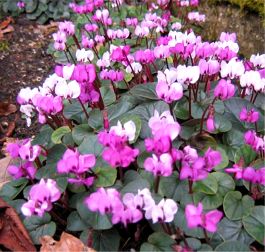
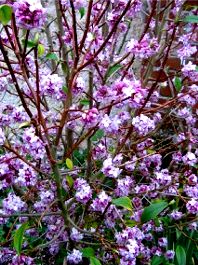
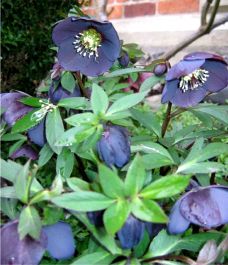
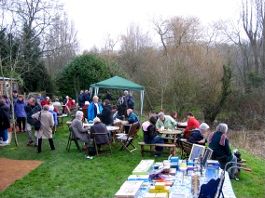
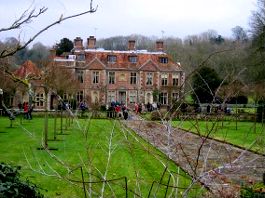 There
are side stalls arranged on snowdrop walk days, including crafts, cakes, preserves
for sale, as well as their own plant centre and gift shop. What was also very welcoming
was a tea hut, serving hot tea or soup, cakes - such as carrot cake, chocolate or
walnut cake. I enjoyed a hot pumpkin and tomato soup, just the ticket to warm myself
through after a chilly walk round the garden.
There
are side stalls arranged on snowdrop walk days, including crafts, cakes, preserves
for sale, as well as their own plant centre and gift shop. What was also very welcoming
was a tea hut, serving hot tea or soup, cakes - such as carrot cake, chocolate or
walnut cake. I enjoyed a hot pumpkin and tomato soup, just the ticket to warm myself
through after a chilly walk round the garden.
If you get the chance, a trip to one of the snowdrop walks at Heale House is well worth it and also the money raised goes to charitable causes. What is there better than this to lift the spirits on a cold dark winter's day?
Heale House Garden
Middle Woodford
Near Salisbury
Wiltshire, SP4 6NT
Tel: (01722) 782504
Website: Click here
Click here for
Local Map
Map courtesy of www.streetmap.co.uk
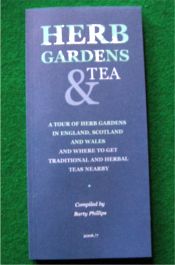 A
A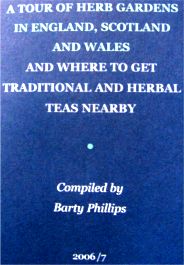 new guide book that will take you to some fascinating and beautiful herb gardens
around England, Scotland and Wales has just been published by author Barty Philips.
Barty has skilfully combined the listings of herb gardens with places nearby where
you can go and enjoy a traditional or herbal tea - a perfect combination.
new guide book that will take you to some fascinating and beautiful herb gardens
around England, Scotland and Wales has just been published by author Barty Philips.
Barty has skilfully combined the listings of herb gardens with places nearby where
you can go and enjoy a traditional or herbal tea - a perfect combination.
There are over 100 herb gardens listed within the book, which gives details on opening times and details on how to get there. Included is a brief descriptions of the gardens and what there is of particular interest, be it in the design or the particular plants that are grown.
For those who enjoy travelling round visiting gardens and enjoying a cup of tea, then this is the essential little guide to keep at hand.
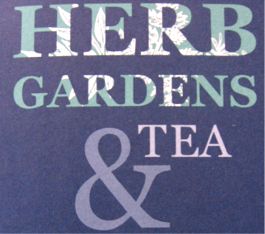 Barty
Philips is the journalist who wrote the silver cleaning article that featured me
in the July 2005 BBC 'Homes and Antiques' magazine. It was, she said, my 'Tea Clipper'
newsletters that inspired her to add the teashop recommendations to this book of
herb gardens.
Barty
Philips is the journalist who wrote the silver cleaning article that featured me
in the July 2005 BBC 'Homes and Antiques' magazine. It was, she said, my 'Tea Clipper'
newsletters that inspired her to add the teashop recommendations to this book of
herb gardens.
I can recommend this book as being of interest to readers of the 'Tea Clipper' who enjoy travelling round beautiful gardens and finding a nice place to enjoy some tea.
To review past newsletters, just follow this link:
Past newsletters.
To subscribe to this free newsletter -
Click here